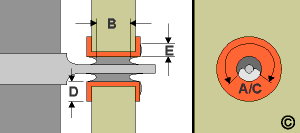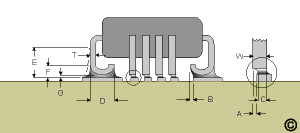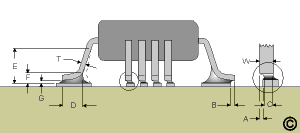Figure 1: Dimensional Criteria for Through Hole Components

Table 1: Acceptable Solder Criteria for Through Hole Components
|
| Feature |
Dim |
Class 1 |
Class 2 |
Class 3 |
| Circumferential wetting on solder destination side of lead and
barrel. |
A |
Not Specified |
180° |
270° |
| Vertical Fill of Solder2. |
B |
Not Specified |
75% |
75% |
| Circumferential fillet and wetting on solder source side. |
C |
270° |
270° |
330° |
| Percentage of original land area covered with wetted solder on
solder destination side. |
D |
0 |
0 |
0 |
| Percentage of original land area covered with wetted solder -
solder source side. |
E |
75% |
75% |
75% |
NOTES
1. Wetted solder refers to solder applied by the solder process.
2. The 25% unfilled volume includes both source and destination side depressions.
|
|
|
Figure 2: Dimensional Criteria for Chip Components

Table 2: Acceptable Solder Criteria for Chip Components
|
| Feature |
Dim |
Class 1 |
Class 2 |
Class 3 |
| Maximum Side Overhang |
A |
1/2W or 1/2P or 1.50 mm (.060") whichever is less |
1/2W or 1/2P or 1.50 mm (.060") whichever is less |
1/4W or 1/4P or 1.50 mm (.060") whichever is less |
| Maximum End Overhang |
B |
Not Permitted |
Not Permitted |
Not Permitted |
| Minimum End Joint Width |
C |
1/2W or 1/2P whichever is less |
1/2W or 1/2P whichever is less |
3/4W or 3/4P whichever is less |
| Minimum Side Joint Length |
D |
Not required |
Not required |
Not required |
| Maximum Fillet Height |
E |
See Note 1 |
See Note 1 |
See Note 1 |
| Minimum Fillet Height |
F |
See Note 2 |
G + 1/4H or 0.50 mm (.020") whichever is less |
G + 1/4H or 0.50 mm (.020") whichever is less |
| Minimum Thickness |
G |
See Note 2 |
See Note 2 |
0.2 mm (.008") (See Note 3) |
| Minimum End Overlap |
J |
Required |
Required |
Required |
|
NOTES
1. The maximum fillet may overhang the land or extend onto the top of the chip
cap metallization; however the solder shall not extend further onto the
component body.
2. Properly wetted fillet evident.
3. Unless satisfactory cleaning can be demonstrated with reduced clearance.
|
|
|
Figure 3: Dimensional Criteria for J Lead Components

Table 3: Acceptable Solder Criteria for J Lead Components
|
| Feature |
Dim |
Class 1 |
Class 2 |
Class 3 |
| Maximum Side Overhang |
A |
1/2W |
1/2W |
1/4W |
| Maximum Toe Overhang |
B |
Unspecified |
Unspecified |
Unspecified |
| Minimum End Joint Width |
C |
See Note 2 |
W - A |
W - A |
| Minimum Side Joint Length |
D |
See Note 2 |
1 1/2 W |
1 1/2 W |
| Maximum Fillet Height |
E |
See Note 1 |
See Note 1 |
See Note 1 |
| Minimum Heel Fillet Height |
F |
See Note 2 |
G + 1/2 T |
G + T |
| Minimum Thickness |
G |
See Note 2 |
See Note 2 |
See Note 2 |
|
NOTES
1. The maximum solder fillet shall not touch package body.
2. Properly wetted fillet evident.
|
|
|
Figure 4: Dimensional Criteria for Gull Wing Components

Table 4: Acceptable Solder Criteria for Gull Wing Components
| Feature |
Dim |
Class 1 |
Class 2 |
Class 3 |
| Maximum Side Overhang |
A |
1/2W or 0.50 mm (.020") whichever is less |
1/2W or 0.50 mm (.020") whichever is less |
1/4W or 0.50 mm (.020") whichever is less |
| Maximum Toe Overhang |
B |
Note 2 |
Note 2 |
Note 2 |
| Minimum End Joint Width |
C |
1/2 W |
W - A |
W - A |
| Minimum Side Joint Length |
D |
W or 0.50 mm (.020") whichever is less |
W |
W |
| Maximum Heel Fillet Height |
E |
See Note 3 |
See Note 1 |
See Note 1 |
| Minimum Heel Fillet Height |
F |
See Note 3 |
G + 1/2 T |
G + T |
| Minimum Thickness |
G |
See Note 3 |
See Note 3 |
See Note 3 |
NOTES
1. Solder fillet may extend through the top bend. Solder must not touch the
package body or end seal, except for low profile SMD devices, e.g., SOICs, SOTs.
Solder should not extend under the body of low profile surface mount components
whose leads are made of Alloy 42 or similar metals.
2. Must not violate minimum design conductor spacing.
3. Properly wetted fillet evident.
|





